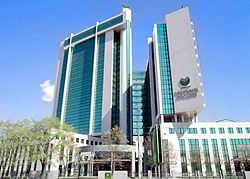Sberbank of Russia
 |
|
 |
|
| Public () | |
| Traded as | MCX: SBER |
| Industry | Banking, Financial Services |
| Founded | 1841 |
| Headquarters | Moscow, Russia |
|
Key people
|
Sergey Ignatiev (Chairman of the Supervisory Board) Herman Gref (CEO, Chairman of the Executive Board) |
| Products | consumer banking, corporate banking, finance and insurance, investment banking, mortgage loans, private banking, private equity, savings, Securities, asset management, wealth management, Credit cards |
| RUB 1300.7 billion (2014) | |
| RUB 290.3 billion (2014) | |
| Total assets | RUB 25.201 trillion (2014) |
| Owner | Central Bank of Russia (51%) |
|
Number of employees
|
over 325,000 |
| Subsidiaries | Sberbank CIB Denizbank Subsidiaries in various European and post-Soviet countries |
| Rating | Ba2 (Moody's), BBB- (Fitch) (2017) |
| Website | www |
Coordinates: 55°41′55.69″N 37°34′45.54″E / 55.6988028°N 37.5793167°E
Sberbank (Sberbank, Russian: Сбербанк, initially a contraction of "сберегательный банк" - sbieriegatielny bank; English: "Savings bank") is a state-owned Russian banking and financial services company headquartered in Moscow. The company was known as "Sberbank of Russia" until 2015. Sberbank has operations in several European and post-Soviet countries. As of 2014[update] it was the largest bank in Russia and Eastern Europe, and the third largest in Europe, ranked 33rd in the world and first in central and Eastern Europe in The Banker's Top 1000 World Banks ranking.
Sberbank's history goes back to Cancrin's financial reform of 1841, when a network of the first state-owned savings banks was created in Russia. By the end of the 19th century, the network reached almost 4 thousand outlets with over 2 million depositors.
Since 1905, savings bank outlets became authorised to sell insurance. After 1910, savings banks started subsidising credit cooperation institutions and extending loans to small lenders. In 1915, savings bank outlets started accepting government securities for depositing.
After the October Revolution of 1917, the state savings banks system continued its activity and growth under the management of the Finance Ministry of the USSR as the State Labour Savings Banks System. From 1926, the saving bank outlets were used to pay wages to blue- and white-collar workers. The savings banks were used to distribute state lottery tickets and for the placement of state bonds with the population. The savings banks introduced wider services such as money transfers.
...
Wikipedia
